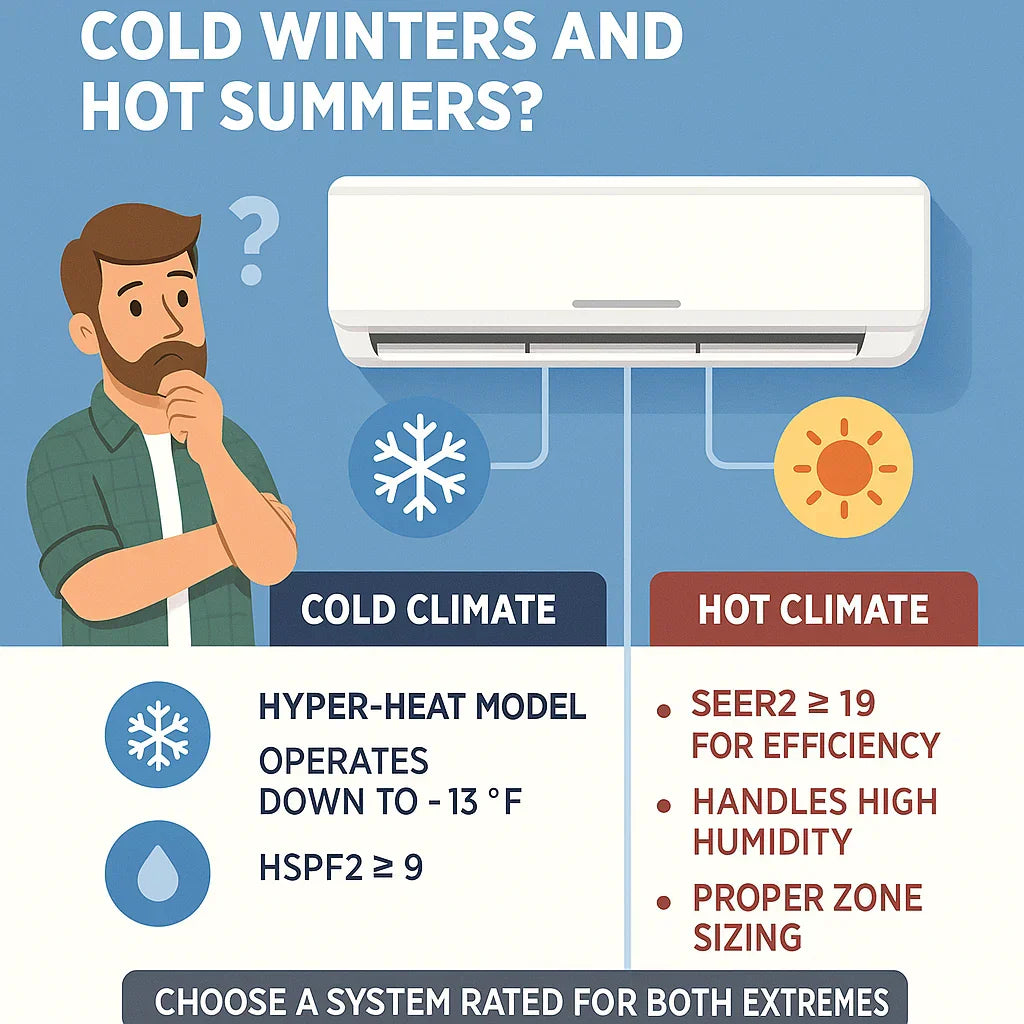If you're Jake—a thoughtful, value-driven homeowner—you want assurance that your 3‑zone ductless mini split system will truly perform year‑round. Sure, you know it works in spring, but can it really deliver on cold winter mornings and scorching summer afternoons? Let's explore how modern systems rise to that challenge—and what to look for when you size and spec yours.
🌍 Understanding the Challenge: Multi‑Season Performance
-
Cold Winters 📉: In climates where temperatures dip below freezing regularly, you need heating capacity that performs reliably down to single digits—or even below zero. Many systems lose heat output as it gets colder; others shut down entirely.
-
Hot Summers ☀️: High cooling load isn’t just about reaching low temps—it’s about managing heat gain from sun, electronics, cooking, and keeping relative humidity in check.
-
Seasonal Extremes → A truly versatile 3‑zone system must have both strong heating capability (measured by HSPF2, low ambient ratings) and powerful cooling (high SEER2).
1. Cold‑Climate Heating: What You Need to Know
💡 Key Features for Winter Performance
| Feature | Purpose |
|---|---|
| Hyper‑Heat / Cold‑Climate Rated | Maintains full output at low temps (e.g., 5°F or –13 °C) |
| Inverter‑Driven Compressor | Modulates power for efficiency and consistent heat |
| Base‑Pan Heater | Prevents coil icing in freezing conditions |
| HSPF2 ≥ 9 | Ensures cost‑effective heating when compared to electric heat |
| Low‑Ambient Kits | Boost performance in severely cold climates |
📎 Learn more: DOE tests show modern heat‑pump mini splits with cold‑climate features can deliver reliable heat down to –10°F; many systems maintain ≥75–85% of rated capacity at 5°F .
2. Hot‑Weather Cooling: Staying Comfortable Under the Sun
🔥 What High Heat Means for Mini Splits
High summer temps mean more than just cooling—zones get hot fast due to solar gains, appliances, and skin effect—while humidity makes air feel heavier. A 3‑zone system must:
-
Deliver sufficient BTUs for each zone
-
Maintain high SEER2 efficiency under full-rated heat
-
Manage moisture during extended cooling cycles
📎 The inverter design helps: variable capacity prevents short‑cycling, keeps the coil cold longer, and improves dehumidification .
3. System Anatomy: Outdoor, Indoor, and What Makes the Difference
A typical 3‑zone mini split system includes:
-
Outdoor Condenser – rated in BTU; should be “hyper-heat” for cold climates or high-SEER2 for heat.
-
Three Indoor Units – wall, cassette, or floor; choose style based on aesthetics and airflow needs.
-
Line Sets & Controls – need proper insulation and wiring for efficiency and safety.
-
Additional Components – such as disconnect boxes, surge protection, and drain lines.
The key is choosing chimney contrast models: those optimized for cold temps and heat removal that also deliver efficient summer cooling.
4. Real‑World Case Studies
🏠 Scenario A: Northern State (e.g., Minnesota)
-
Climate: Winters below 0°F, summers reach 90–100°F with high humidity
-
System: 36k BTU, hyper-heat 3‑zone mini split
-
Performance:
-
Heating: maintains ~90% capacity at 5°F, falls to 75% at –5°F. Backup electric kickers handle lowest temps.
-
Cooling: SEER2 ~20; comfortable and dehumidified even at 95°F.
-
🏠 Scenario B: Southern State (e.g., Florida)
-
Climate: Mild winters, hot and humid summers (~35°C, high dew points)
-
System: 36k BTU, high-SEER2 (≥21), 3‑zone mini split
-
Performance:
-
Heating: supplemental heat usually not needed; system handles cold mornings (~50°F) easily.
-
Cooling: rapid response to heat; long run times reduce humidity by 20–30%.
-
5. Sizing and Spec’ing for Extremes
🛠️ For Cold Winter Heating
-
Choose condenser rated for full capacity at ≤5°F (look for “H2i” or “XLTH” branding)
-
Ensure HSPF2 ≥ 9
-
Include base pan or defrost heater
🛠️ For Hot Summer Cooling
-
Select SEER2 ≥ 19 for efficiency under full load
-
Match BTUs to zones with 10–20% buffer
🔄 Balanced Sizing
-
Mix zone loads; e.g., 12k + 12k + 12k = 36k unit.
-
For dual extremes, a 42k condenser with 18k + 12k + 12k heads can offer flexibility.
6. Installation and Maintenance Tips
-
Insulate line sets to prevent heat loss or pickup
-
Elevate outdoor unit to avoid snow cover or flooding
-
Clear airflow around condenser
-
Check filters monthly, especially during peak seasons
-
Clean coils annually
-
Update firmware/control settings to match seasonal patterns
7. Budgeting for Performance
Expect this price range in 2025:
| Climate Needs | Unit Type | Estimated Cost (Unit Only) |
|---|---|---|
| Cold-climate Hyper-Heat | 36k 3‑Zone system | $4,500–$6,500 |
| Standard High Season | 36k high-SEER2 system | $4,000–$5,500 |
| Premium System | 42k + cold/hot specs | $5,500–$8,000 |
📎 Rebates: Many cold-climate cold + high SEER qualify for rebates ($300–$1,200), especially on ENERGY STAR® models .
📘 Summary: Jake’s Decision Matrix
-
Identify climate zone → North? Go hyper-heat. South? SEER2 high is priority.
-
Pick a system rated for BOTH extremes
-
Size each zone carefully for your layout
-
Plan for installation that protects performance (elevated condenser, insulation, clearances)
-
Maintain annually for lasting efficiency
-
Explore rebates and cost offsets
External References
🧭 Final Takeaway
Yes—a properly chosen, installed, and maintained 3‑zone mini split can absolutely handle the full range of temperatures. It just needs the right spec sheet and a little attention. Ready to explore units for your ZIP code? Just tell me your climate zone and budget, and I’ll help you narrow it down.
Want me to turn this into a formatted piece with visuals, pricing links, and a DIY installation checklist?
In the next topic we will know more about: 3-Zone Mini Split vs. Central Air: What Jake Should Consider







